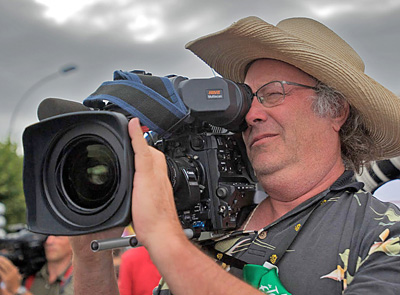
John Sharaf
John Sharaf Photography
One of the most compelling reasons to use the Sony SRW9000, F23 or F35 is the Sony Log Curve feature, also known as “S-Log”. This allows extended dynamic range of twelve stops vs. a more typical range of 8 stops in a conventional 709 picture. Of course it’s the ability to record 10-bit depth on the accompanying HDCAM-SR recorder (either the attached SRW-1 or the on-board SRW9000) allowing non-destructive color correction in post-production that completes the required work-flow.
Making the proper exposure for the log curve on a consistent basis is the main hurdle for the digital cinematographer. These cameras help by providing a readout of the ASA based on the gain setting on a display on the operator’s side of the camera. Nominally the SRW9000 is 960ASA at the +6Db setting which allows the maximum 800% Dynamic Range, and the latest software on the F35 offers 800ASA at 0Db. Knowing and trusting the ASA encourages the use of an exposure meter for lighting and setting the exposure, and makes the whole experience more like shooting film. The use of DSC’s prototype “S-Log Chart” allows both great confidence in confirming the stated speed and/or setting the exposure with the aid of a waveform or even by the cameras’ internal zebras.
The S-Log Chart consists of a large 50% mid-gray field around a smaller 90% white chip, similar to what you’d find on a conventional chip chart but with much larger targets for the purpose of reading the exposure on a waveform monitor or the zebras in a viewfinder. In the S-Log mode, mid-gray should be set to 38% on the scope and the white chip at 68%. This creates a somewhat compressed picture while allowing “head-room” above the white for objects found in the real world that are essentially “brighter” than white. With the chart, a camera set to S-Log, an incident lightmeter and a waveform monitor you have everything you need to confirm the speed and set the proper exposure. Read the incident exposure on a flatly lit chart, either in an engineering environment or the real world, set the lens iris appropriately, and then note that the resulting waveform puts the middle gray and white where it belongs; this confirms the correctness of the system. Furthermore, because these camera also have built in LUT’s to convert the monitoring output to a 709 standard, you will notice that in that mode, the gray is displayed as 50% on the waveform and the white at 98-100%, just as you would expect.
The DSC “S-Log Chart” provides a valuable tool therefore, in learning how to use, gain confidence in, and properly expose your subject when using the Sony S-Log feature. As 10 bit recording becomes more ubiquitous in digital cinema cameras the use of log curves and raw recording will as well, and cinematographers will have to learn new tricks, and use new tools to set exposures that will result in pictures with extended dynamic range. Whatever the curve; S-Log, C-Log, RED Raw, etc. an easily read chart that targets the middle gray and the white chip will be invaluable. My thanks to David and DSC Labs for building such a tool.

